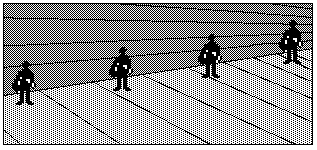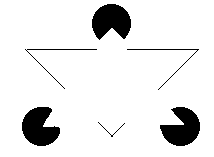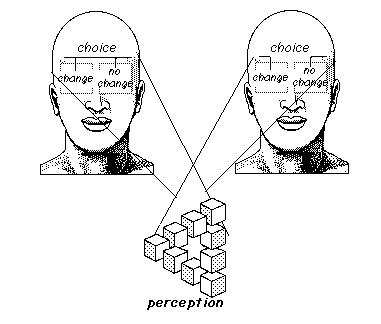We entertain a notion of the integrity and completeness of our own experience in that we believe all parts of it to be relatable because we are, in some vital sense, the experience itself.
D. Bannister
In order to plan our future and to make choices we have to be able to anticipate our behaviour in future situations. Therefore to try and understand oneself is not simply an interesting pastime, it is a necessity of a creative life. Self-knowledge is a practical guide to assess my skills in dealing with change. For change is not easy and therefore requires creative thinking on how to approach it. It requires the ability to understand why others see things the way they do. Stand in their shoes and then creating an environment in which they start asking questions, especially if they feel they know all the answers. Standing in other people's shoes is hardly possible if I don't even know myself.
So what actually happens in the way of perception?
Contrary to accepted views, H. Maturana and F. Varely, argue that all living systems are organizationally closed. They are autonomous systems of interaction that make reference only to themselves. So when there is a necessity for change I will only experience this as necessary when I have knowledge or can associate the new data with information I already have. If no such information is available I will simply not accept or even see the need for change! When we receive 'misleading' information we interpretate instead of look. for instance, the four figures in the picture have the same size. The perspective deceives us.

The idea that living systems are open to an environment is, in their view, the product of an attempt to make sense of such systems from the standpoint of an external observer. They base their argument on the idea that living systems are characterized by three principal features: autonomy, circularity, and self-reference. These lend them the ability to self-create and self-renew. All living systems strive to maintain an identity by subordinating all external changes to the maintenance of their own organization as a given set of relations. They do so by engaging in circular patterns of interaction whereby change in one element of the system is coupled with changes elsewhere, setting up continuous patterns of interaction that are always self-referential. They are self-referential because a system cannot enter into interactions that are not specified in the pattern of relations that define its organization. If not known or recognized within, it is not seen outside.
Our brains automatically fill in missing information. You will also no doubt see the white triangle.

The white triangle is not there. The eye does not deceive us but the brain creates a pattern on basis of what it expects. This made the philosopher Wittgenstein say: "Don't think, look."
This does not mean that living systems are completely isolated. The closure and autonomy to which Maturana and Varela refer is organizational. Living systems close in on themselves to maintain stable patterns of relations, and that it is this process of closure or self-reference that ultimately distinguishes a system as a system. Systems are like Russian dolls or Chinese boxes, they can be seen as being made up of wholes within wholes: 'There is no end to smallness' Chuang-tzu.
It can be compared to the functioning of the human brain: which is often viewed as making representations of the environment, recording these in memory, and modifying the information thus stored through experience and learning. Maturana experimented with frogs and found that the brains do not reproduce a picture of the world like a camera, but make calculations like music reproduced from a compact disc. Disc and player form a closed system, and the player even corrects minor defects! It refers to data before and after the flaw and then produces a sound it considers most likely! Therefore an absolutely true picture of the disc (=world) would be impossible.
Maturana and Varela argue that the brain is closed, autonomous, circular and self-referential. They argue that the brain does not process information from an environment, and does not represent the environment in memory. Rather, it establishes patterns and points of reference that reflect its own mode of organization. The system thus organizes its environment as part of itself. The idea that the brain can make representations of its environment, presumes some external point of reference from which it is possible to judge the degree of correspondence between the representation and the reality. Clearly this cannot be so. Their work identifies this paradox and suggests that the brain creates images of reality as expressions or descriptions of its own organization and interacts with these images, modifying them in the light of actual experience. The theory of autopoiesis thus recognizes that systems can be recognized as having "environments", but insists that relations with any environment are internally determined.
So every human being is a closed system. When I want to change someone else I cannot do so directly, I can only do this by changing myself. This implies analysis. Next I will have to invent manners to present information or data into the other's field of perception. This may then be perceived by the other and may motivate her/him to change if the need is recognized.

Thus we have a triangular situation, the creativity should be directed at finding ways and manners to change the environment; to move into the perceptions of the other. Thus others can convince themselves of the need for change on basis of the facts they are able to see.
This means that any change can only be effected indirectly . And most discussions are proof of this. Opponents hardly ever listen, they just use the listening time to find new arguments or detect weaknesses in the opponent's arguments. Various creative thinking techniques try to deal with this particular difficulty, for instance, brain-storming, mind-storming. The brain is very good at forming patterns, in fact all information is stored in patterns. The main difficulty seems to be to step out of existing patterns and actively create new patterns.
As the saying says 'Seeing is believing' yet the difficulty seems to be to see.
[back to start Creativity Explored in Gulliver’s Footsteps]
[back to Index]